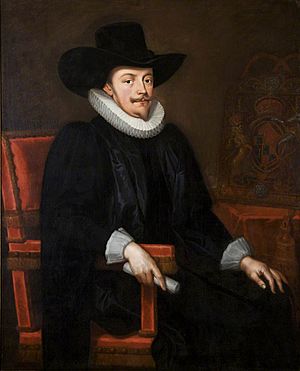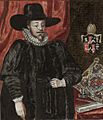John Williams (archbishop of York) facts for kids
Quick facts for kids The Most Reverend and Right Honourable John Williams |
|
|---|---|
| Archbishop of York | |

Portrait by Gilbert Jackson
|
|
| Enthroned | 1641 |
| Reign ended | 1646 (episcopacy abolished) |
| Predecessor | Richard Neile |
| Successor | Accepted Frewen (1660) |
| Other posts | Bishop of Lincoln (1621–1641) |
| Personal details | |
| Born | 22 March 1582 Conwy, Wales |
| Died | 25 March 1650 (aged 68) Gwydir, Wales |
| Buried | Llandygai Church |
| Nationality | Welsh |
| Denomination | Anglicanism |
| Education | Ruthin School |
| Alma mater | St John's College, Cambridge |
John Williams (born March 22, 1582 – died March 25, 1650) was an important Welsh church leader and a trusted advisor to King James I. He held several high-ranking positions. These included being the Bishop of Lincoln from 1621 to 1641. He also served as the Lord Keeper of the Great Seal from 1621 to 1625. Later, he became the Archbishop of York from 1641 to 1646. He was the last bishop to also serve as a lord chancellor.
Contents
Early Life and Education
John Williams was born in Conwy, Wales. He was the second son of Edmund Williams and Mary Wynn. Unlike many church leaders of his time, John came from a well-known family.
He went to Ruthin School and then studied at St John's College, Cambridge. He earned several degrees there. In 1603, he became a fellow, which is like a senior researcher or teacher. He also worked as a University Proctor.
John joined the church as a clergyman. He first impressed King James I with a sermon he gave in 1610. By 1617, he became the king's chaplain. This meant he was a personal religious advisor to the king.
Political Career and Challenges
In 1620, John Williams became the Dean of Westminster. This was a very important church role. Soon after, King James I made him the Bishop of Lincoln. He also appointed him Lord Keeper of the Great Seal in 1621. This was a powerful government job.
Williams was a strong supporter of King James I. The king valued him because he understood what the king wanted. However, John Williams upset Prince Charles, who later became King Charles I. Williams did not approve of Charles's trip to Madrid with the Duke of Buckingham.
When King James I died in 1625, Charles I became king. Williams was quickly removed from his government role as Lord Chancellor. He was also stopped from attending Parliament. Even though the Duke of Buckingham was later killed, Williams remained out of favor. He made enemies with William Laud, who became Archbishop of Canterbury in 1633. Laud and his friend Thomas Wentworth, 1st Earl of Strafford had a lot of influence with King Charles I.
Williams had more open-minded views towards a group called the Puritans. This led to problems with the Court of the Star Chamber. This was a special court that dealt with political cases. Williams was accused of revealing government secrets. In trying to defend himself, he faced new accusations. He was found guilty of some charges in 1636. As a result, he was suspended from his church roles, fined, and sent to the Tower of London. He stayed there until 1640.
William Laud expected Williams to resign as Bishop of Lincoln after his conviction. But Williams refused to give up his position. He stayed at his home, Buckden, until his imprisonment.
Later Years and Legacy
In 1640, members of Parliament forced the King to release John Williams. Williams then returned to his duties. He tried to find a middle ground between the different groups in the Church. He supported the removal of both Laud and Strafford from their positions. He even advised the King not to save Strafford's life.
In 1641, Parliament imprisoned him again. But he was released on bail in 1642. He then joined the King in Yorkshire. He was also officially made Archbishop of York that year. However, his time in Yorkshire was short. He spent his last years in his home region of North Wales. At first, he supported the King's side in the English Civil War. But by 1646, he made peace with the local Parliamentarian leader.
On October 9, 1646, Parliament removed him from his position as Archbishop. This happened because the role of bishops was ended during the time of the Commonwealth and the Protectorate.
John Williams died in 1650 from a throat infection called quinsy. He was staying with his relatives, the Wynns, at Gwydir. He was buried at Llandygai Church. He had bought back his family's old estate, which then went to his nephew, Sir Griffith Williams. His great-nephew, John Dolben, also became an Archbishop of York later on.
You can find more details about John Williams's activities during the Civil War in North Wales in Norman Tucker's book Prelate at Arms. He is also a main character in Tucker's fictional book Castle of Care.
Images for kids
-
John Williams, from A Tour in Wales by Thomas Pennant (1726-1798) that chronicle the three journeys he made through Wales between 1773 and 1776




